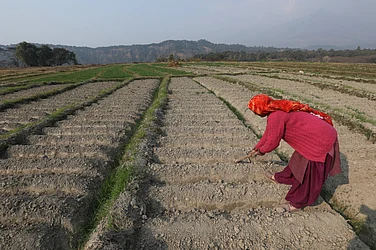Battling terrorism in Kashmir, militancy in Punjab and insurgency in the Northeast, security agencies failed to notice the Maoist threat spreading across the country. By the time the enormity of the problem hit home, almost 40 per cent of the hinterland was under Maoist influence, making the then PM Manmohan Singh call it the biggest internal security challenge in 2009. Experts in the security establishment say it was already a little too late for the government to realise it.
In terms of geographical expanse, the influence of Maoism, or Left Wing Extremism (LWE) as North Block officials call it, was being felt in a swathe of territory across 10 states—Bihar, Jharkhand, Orissa, Andhra Pradesh, West Bengal, Maharashtra, Telangana, Madhya Pradesh, Uttar Pradesh and Chhattisgarh—that began to be called the ‘red corridor’. “In terms of actual operational area, LWE straddles territory that is four times more than Punjab militancy, Kashmir terrorism and the Northeast insurgencies put together,” says a senior official in the Ministry of Home Affairs (MHA). “It is certainly no mean task to get a grip over the situation.”
He concedes the central government took some time to understand the gravity of the problem, and even thereafter it failed to come up with a coherent strategy to deal with the Maoists. “From the then home minister Shivraj Patil, who called violent, gun-toting Maoists ‘misguided children of the country’ to P. Chidambaram, who gave the home ministry’s fax number and asked Maoist leader Koteshwar Rao alias Kishenji to send him a 72-hour truce proposal in writing, the initial attempts were non-serious and almost laughable,” recalls the official.
Serious efforts were made by individual states, though. “Andhra Pradesh’s special police force, the Greyhounds, was successful in tackling the Maoists, but that was clearly not the solution. With contiguous states forming the corridor, the Maoists simply crossed over to the neighbouring state. A coordinated effort was needed,” the official says.
Over the past few years, the Centre has come out with a National Policy and Action Plan (NPAP) to deal with LWE. According to a government spokesperson, NPAP envisages “an integrated approach in terms of security, development of the region, enforcing rights and entitlements of local communities, public perception management and good governance”.
The 106 Maoist-affected districts have been graded based on incidents of violence, activities of Maoists, including their sympathisers and overground workers, and the development work that is needed. They get upto Rs 30 crore annually from the centre for development work. Forty-four of the 106 districts were declared worst-affected and get special attention and funds for infrastructure creation.
To tackle Maoist violence, 120 battalions (more than 100,000 security personnel) have been deployed across the affected areas and the plan is to go after the top leadership and eliminate them. After an identified area is cleared of Maoist presence, it is expected to be followed up with development work. Going by MHA figures, 222 LWE cadres were killed in 2016 while only 89 had been eliminated the previous year. Also, 1,840 Maoists were arrested in 2016 as against 1,668 in 2015. Home ministry officials claim that in addition to increased presence of security personnel, decline in violence can also be attributed to better monitoring of development schemes in affected areas and insurgency fatigue among Maoist cadres.
Vishwa Ranjan, former Director General of Police (DGP) of Chhattisgarh says that even though security forces have managed to clear some areas, their response has been mostly ad hoc and reactive. “There doesn’t seem to be a long-term plan in place,” he says. “They are living day-to-day. In Chhattisgarh, the Maoists are still deeply entrenched in some districts such as Sukma, Dantewada and parts of Bastar in particular. The objective should be to dislodge them from these districts through continuous security operations. Small intelligence-based operations to kill the Maoists seem to be the present strategy. These hit-and-run operations would hardly dent their military and political structures. The security forces have to stay and put continuous pressure to force the Maoists to leave the area until they have nowhere to run.”
The Maoists, on the other hand, are organised, well-trained and ruthless. “The Maoists, especially their leadership, are trained like modern soldiers, maybe even better,” the former DGP, who had led Operation Green Hunt against the Maoists, tells Outlook. “They are experts in guerilla warfare, which is now being upgraded to mobile warfare. They are adopting army tactics of moving in companies of 100 people each. Their documents show they are intelligent and capable of staying ahead of the forces.”
The Maoists also know the jungles better. Densely forested regions like Bastar present a particularly tough challenge to the security forces. The terrain is difficult to dominate and sanitise by even a large number of personnel. Moreover, inadequacies in handling armed Maoists have caused serious casualties of civilians and security forces—213 civilians and 65 security personnel in 2016 alone. Politicians, fearing assassination bids, prefer not to go into Maoist-infested areas even to campaign. Extortion (‘tax-collection’ by Maoists) continues without any fear of reprisal. They are believed to be taking “protection money” from contractors, businessmen and also from the mining mafia operating in states like Orissa and Jharkhand. There have also been reports of Maoists linking up with Kashmir-based terrorists, Northeast insurgent groups and even the LTTE for training in manufacturing explosives.
“The Maoists use extortion money to fund their activities and buy explosives and ammunition. The arms are generally looted from the security forces,” says Ranjan, who believes Maoists have been losing some of their sympathisers among the locals because of their coercive tactics. “Their jan adalats are like kangaroo courts where they try people and order their execution after labelling them as police informers. Also, with Maoists interfering in some of the traditional ways of tribals and other locals, they are losing their faith in them.”
MHA sources say there are other reasons why the locals are losing their faith in Maoists. “CPI (Maoist) cadres project themselves as the messiah of poor tribals and claim to be fighting for their rights. But tribals are now realising they are actually being exploited under the shadow of the gun. There is almost no presence of tribals at the top, including the politburo and the central committee. Most of the tribal cadres are used as footsoldiers,” says an MHA official.
There are only two Santhali tribals from Jharkhand—Misir Besra alias Sunirmal, a politburo member, and central committee member Nago Manjhi alias Pralay da—at the top level, but their presence is largely symbolic. Also, there are no members from Chhattisgarh and Orissa, where the Maoists have been active for the past 40 years, in the politburo or central committee. The majority of senior leaders belong to Andhra Pradesh and Telangana.
Another sore point among the tribals is that while their children are forced to give up education, wards of senior Maoist leaders are pursuing the best education in metropolitan cities and then working with corporates, including multinational companies they love to denounce. For example, the son of Deo Kumar Singh, a central committee member in Jharkhand, did a masters in chemistry at IIT Kanpur and is the CEO of a software firm. He earlier worked for an American company, earning in US dollars.
“The son of CPI (Maoist) general secretary, Muppala Laxman Rao alias Ganapathy, lives in the US, a country considered by them to be the torchbearer of imperialism and the source of all economic evils,” says the MHA official, based on intelligence reports. Ganapathy’s son is known to have studied at an engineering college in Chittoor and also worked with IBM.
Even as reports of exploitation of children and tribal women are coming out, resistance is also building up among the locals. “The Maoists have used villagers as human shields in encounters with security forces. They siphon off the PDS ration. The support for Maoists is definitely down,” the official adds.
Disillusioned by the degeneration of the movement, many leaders and cadres have surrendered to the police. Senior Maoist leader Balkeshwar Oraon alias Bada Vikas surrendered in Jharkhand last year after having spent 25 years in the armed wing of the party. Increased pressure from the security forces is also pushing more cadres to surrender. A record number of 1,442 Maoist cadre surrendered in 2016 as against 570 in 2015.
Security expert Ajai Sahni says LWE is definitely a receding threat as security forces have had several operational successes. However, he cautions that Maoists have been resilient enough to revive themselves. According to him, conditions for the resurgence of violence will re-emerge if the government does not follow economic policies that guarantee equity and equality. “Globally, there has been a marginalisation of human labour with technological advances. Man is becoming redundant even as population is growing. Karl Marx had said that the more useful things we have, the more useless people we will have. The government needs to reform its economic model,” he says.
Warning against any hurry to declare victory, Sahni says, “The beginnings of neglect are already creeping in. This is the security paradox. As the security agencies achieve some success, it leads to less spending and then things get messed up. The government has already shrunk the list of most-affected districts. There is a tendency by the forces to neglect Standing Operating Procedures while patrolling in jungles. If there is no concrete long-term economic and security plan, the Maoists will re-emerge stronger.”


























